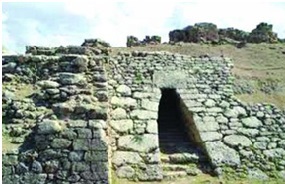(ST) – The greatest human civilizations were born on the Syrian soil where man invented miracles that their remnants are still scattered and high in every corner. Ugarit invented the first alphabet in the world to become the mother of all alphabets in the world as well as its considerable impact in spreading science, culture and knowledge to the peoples of earth.
Clay tablets discovered in Ugarit show through written documents that the kingdom had distinguished diplomatic relations with the outside world at that time and possessed an organized army that had the ability to maintain its security and stability being the focus of attention of many who had the desire of expansion.
The kingdom was located in an area disputed by two great powers during the Bronz age pharaohs in the south and the Hittites in the north.
Director of Ugarit Archaeological Site in Lattakia, Mr. Ghassan Al Qayem, said that clay tablets confirms that the kingdoms’ army occupied a high and significant position and it was the important tool that ensured the survival of the kingdom of sovereign economy and booming trade as well as its ability to develop its military system and maintain its presence.
The army material consisted of the infantry and chariots while most members of the army were soldiers from various cities and regions of the kingdom. Texts discovered in the royal palace indicated the existence of helmets, armor, gears, spears, swords, bows, and arrows as well as chariots carrying individuals, led by a man or two and drawn by two horses, as deemed the most important military equipment to the armies of that era.
The city of Ugarit (known locally as Ras Shamra), 13 km north of Lattakia was the capital of the ancient kingdom of Moreih during the third millennium B. C. It is considered one of the most important Bronze Age sites in the Middle East.
The kingdom stretches over a height of twenty meters and an area of 36 hectares. The kingdom is a village along the seashore and communicates with the Mediterranean countries of the world through its famous port, a few kilometers north of the modern city of Lattakia.
Ugarit became an independent kingdom in the 18th century BCE. The tablets found in the palace archives have revealed its military and economic history. The Canaanites had a golden age there from about 1450 to 1200 BCE, when they produced great royal palaces, temples and shrines, a high priest’s library and various other libraries on the acropolis with their strong ship built from the cedars, they became the greatest naval power of the age and developed many key principles of navigation.
They traded textiles, ivory, weapons and silver with the cities of the Mediterranean, Mesopotamia, the Aegean Sea, Egypt and Asia.
Akkadian was the international language. Around 1200 BCE, Ugarit was probably invaded and destroyed by northern tribes sometimes called the Sea Peoples. However, other possibilities like a big earthquake, a famine or a massive fire have not been ruled out. Its population then was probably less than 10,000.
Ugarit’s location was forgotten until 1928 when a peasant accidently opened an old tomb while he was cultivating a field. The discovered area was the Necropolis of Ugarit. Excavations have since revealed an important
an important city that takes its place alongside Ur and Eridu as a cradle of urban culture, with a prehistory reaching back to 6000 BCE. The reason may be that it was both a port and was at the entrance of the inland trade route to the Euphrates and Tigris lands.
Texts and tablets discovered at this site reveal the use of eight languages at that time. Much of the diplomatic correspondences is in Babylonian (or Akkadian) the trade language of the region. Other texts have been found in Hurrian, Cypro, Minoan, Hittite and Sumerian, Cuneiform, as well as inscriptions in Hittite and Egyptian hieroglyphic.
Scribes in Ugarit appear to have started the Ugaritic alphabet around 1400 BC thirty letters, corresponding to sounds, where adapted from cuneiform characters and inscribed on clay tablets.
A debate exists as to whether the Phoenician or Ugaritic alphabet was used first. while many of the letters show little or no formal similarity, the standard letter order (preserved in our own alphabet as A, B, C, D, etc.) shows strong similarities between the two, suggesting that the Phoenician and Ugaritic systems were not wholly independent inventions.
Excavations in the site showed that Ugarit was one of the most famous Syrian kingdoms in the history of the ancient Near East. The most important elements in this discovery is the manuscripts on clay tablets which tell us about the heroic poems, mythologies, the divine complex and the life prevailed in the second half of the second millennium BC in Ugarit
Two main temples were discovered in Ugarit dates back to second millennium BC. Between the two temples, there were a big house for priests and included a religious library, a warehouse containing 74 pieces of weapons, bronze tools which represented as an offering made by crafts men working in bronze industry to the high position priest.
The ministry of Tourism is keen to point out the importance of the site. There are substantial remains on view at Ugarit, particularly the royal Palace complex. Important artifacts discovered at Ugarit can be seen in the National Museums in Damascus and Aleppo.
Sharif al -Khatib

